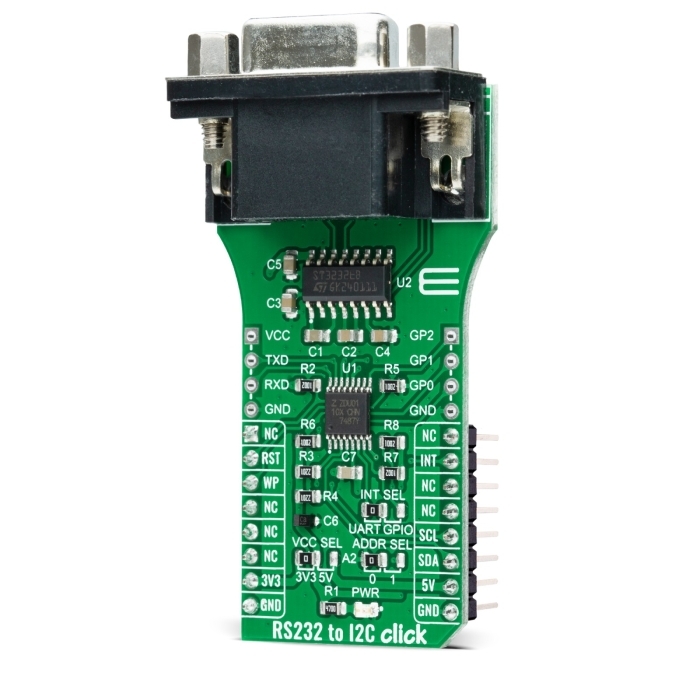MIKROE RS232 to I2C Click
RS232 to I2C Click is a compact add-on board representing a universal usable RS232 to I2C converter.
Product Overview
RS232 to I2C Click is a compact add-on board representing a universal usable RS232 to I2C converter. This board features the ZDU0110RFX, a bridge between a UART port and an I2C bus from Littelfuse, which at the same time represents the connection between the MCU and the RS232 line driver and receiver, the MAX3232. The ZDU0110RFX provides full-duplex asynchronous communications with a 128 byte FIFO buffer, of which 64 bytes each are allocated to receive and transmit operations. It also contains a 4kbit EEPROM and GPIO with programmable interrupt capability; programmable interrupts and interrupt lines for UART and GPIO notifications. This Click board™ is suitable for use in multiple applications such as communication bridges, process and automation control, terminal servers, and many more.
RS232 to I2C Click is supported by a mikroSDK compliant library, which includes functions that simplify software development.
RS232 to I2C Click as its foundation uses the ZDU0110RFX, a digital UART interface IC designed to give you an I2C-controlled UART interface from Zilog. The ZDU0110RFX provides full-duplex asynchronous communications with a 128B FIFO (First In, First Out) buffer, allocating 64 bytes each to the receive and transmit operations. This interface bridge simultaneously represents the connection between the MCU and the RS232 line driver and receiver, the MAX3232, which completes this solution by making it a complete RS232 to I2C converter.
The MAX3222 is a low-power and high speed up to 1Mbps RS232 transceiver. It runs at data rates of 120kbps while maintaining RS-232 output levels. This transceiver is connected to the DB9 Female Connector, compliant with TIA/EIA-232-F standards which provides the users an electrical interface between an asynchronous communication controller and the serial-port connector. Alongside RS232 TX and RX signals, the DB-9 connector also carries flow control signals (CTS and RTS) for maximum reliability.
RS232 to I2C Click communicates with MCU using the standard I2C 2-Wire interface that supports Standard-Mode (100 kHz) and Fast-Mode (400 kHz) operation. Besides, the ZDU0110RFX allows choosing its I2C peripheral address using the onboard SMD jumpers labeled as ADDR SEL. The selection can be made by positioning the SMD jumper to an appropriate position marked as 0 or 1. This fully programmable UART IC is preconfigured to operate at a 57.6kb/s rate, so configuration is not required to access the UART or the EEPROM. The ZDU0110RFX also contains a 4kbit EEPROM and General Purpose Input and Output (GPIO) with programmable interrupt capability.
The EEPROM is accessible via I2C communication and comes with the configurable Write Protection function labeled as WP routed on the CS pin of the mikroBUS™ socket, and an active-low reset signal routed on the RST pin of the mikroBUS™ socket. The WP pin protects the EEPROM memory from write operations and must be set to a high logic state to inhibit all the write operations. Also, the ZDU0110RFX provides separate programmable interrupts, and interrupt lines for UART and GPIO notifications. These individual interrupts mean the controlling device doesn't have to poll the UART IC for data. The interrupt selection can be made by positioning SMD jumpers labeled as INT SEL to an appropriate position marked as UART or GPIO, and processed by the INT pin of the mikroBUS™ socket.
In addition to UART communication pins from the mikroBUS™ socket, the user can connect the TX/RX signals directly through the UART external connection header on the left side of the board, while previously mentioned GPIO pins can be connected to the General Purpose I/O header on the right side of the board. The two pins on this header, GP0 and GP1, are GPIO pins that possess an interrupt function.
This Click board™ can operate with both 3.3V and 5V logic voltage levels selected via the VCC SEL jumper. This way, it is allowed for both 3.3V and 5V capable MCUs to use the communication lines properly. However, the Click board™ comes equipped with a library containing easy-to-use functions and an example code that can be used, as a reference, for further development.
Features & Specs
- Interface: I2C
- Compatibility: mikroBUS™
- Dimensions: 57.15 x 25.4mm
- Input Voltage: 3.3V or 5V
- Data Rate: 57.6 kb/s
- EEPROM Memory Size: 4 bits
- Operating Temperature Range: Min. -40°C, Typ. +25°C, Max. +85°C
Documentation
Customer Reviews

Stock and Customer Discounts
Available Discounts
- $11.35 | 25+ units
- $10.76 | 100+ units







